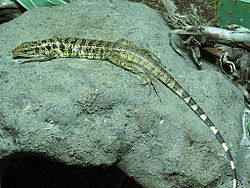Tupinambis
| Tupinambis | |
|---|---|
 |
|
| Tupinambis teguixin | |
| Scientific classification | |
| Kingdom: | Animalia |
| Phylum: | Chordata |
| Class: | Reptilia |
| Order: | Squamata |
| Family: | Teiidae |
| Genus: |
Tupinambis Daudin, 1802 |
Tupinambis is a lizard genus which belongs to the family Teiidae, and contains seven described species. These large lizards are commonly referred to as tegus (teiús in Portuguese); T. merianae (Argentine black and white tegu), T. rufescens (red tegu), and T. teguixin (gold tegu) are popular in the pet trade. They are primarily found in South America, although T. teguixin also occurs in Panama. Tegus that have escaped or have been illegally released have adapted and are increasing in several Florida counties including rural and suburban (especially south Miami-Dade and Hillsborough) counties, agricultural areas (especially Homestead and unincorporated Miami-Dade County, Florida) and publicly owned conservation areas (especially Southern Glades Environmental and Wildlife Area and southeast margin of Everglades National Park) of South Florida See invasive species website (www.IVE-GOT-1.org) for details with specific locations of credible observations and voucher specimens.
In 2012 a number of tegu species were reclassified from Tupinambis to the previously used genus Salvator. The newly proposed classification comes from a restructuring of the Teiidae family based upon the study of 137 morphological characteristics. The new classification is as follows: Salvator duseni (yellow tegu), Salvator rufescens (red tegu), Salvator merianae (black and white tegu), Tupinambis teguixin (gold tegu), Tupinambis longilineus (Rhondonia tegu), Tupinambis palustris (swamp tegu), Tupinambis quadrilineatus (four-lined tegu).
Tegus are large reptiles, with some species reaching a total length of around 1.23 m (4.0 ft), and a weight of approximately 6.8 kg (15 lb). These opportunistic, wide-ranging lizards can be found in a variety of habitats, from swamps to rainforests to savannahs and cities. Although terrestrial, they are capable swimmers, able to remain submerged for up to 22 minutes and having even been caught in gill nets set at sea.Tupinambis have heterodont dentition consisting of four different types of teeth. Incisor-type—tricuspid—teeth reside at the tip of the mouth. Recurved canine-type teeth occur further back on the tooth row. Behind those reside a separate set of incisor-like teeth (though flattened in a perpendicular plane to the first set of incisors). The rearmost teeth are blunt, rounded, peg-shaped teeth. The rearmost two tooth classes only occur in sexually mature individuals thus indicating an ontogenetic shift in tooth morphology. Along with changes in tooth type, the frequency of each tooth type also changes with ontogeny, without an overall changes in tooth count (approximately 70 teeth). Rather than increase tooth count, the teeth themselves increase in size as the jaw grows from hatchling to adult. This ontogenetic shift in tooth morphology suggests a shift in diet with age, however few dietary studies have been done to support this claim and limited stomach content observations do not show much variability between hatchlings and juveniles. Biomechanical studies have shown that Tegus have stronger limb bones than comparably-sized mammals or birds, a trait that may be inherent to amphibians and reptiles. They exhibit social and maternal behaviour; female Tegus construct burrows to lay their eggs in, and will protect their brood until they hatch. Up to 35 eggs are produced in a clutch. Tegus will hibernate together in groups, though males exhibit territorial behavior towards each other. Tegus exhibit sexual dimorphism. Males display greatly expanded and prominent "jowls" along the base of the lower jaw. These jowls are the result of extensive growth of the ventral pterygoideus muscles (a prominent jaw closing muscle in reptiles). Though both sexes exhibit hypertrophy of the ventral pterygoideus muscle, likely in response to their durophagous habits, male Tupinambis show both greater relative and absolute muscle mass compared to females. Further evidence for sexual selection of these jowls comes from observations that ventral pterygoideus muscle mass increases in males during the reproductive season. Metabolic changes also occur during the reproductive season, in which the body temperature is increased up to 10 degrees and sustained internally like a bird or a mammal. This discovery has major evolutionary implications, providing support for the hypothesis that endothermy may have evolved in response to parental care.
...
Wikipedia
